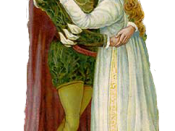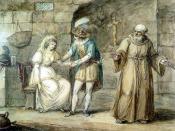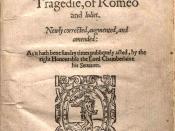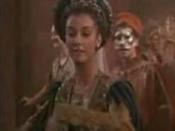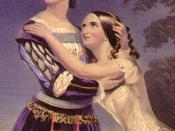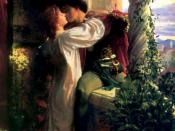The Tragedy of Romeo and Juliet Light shapes our lives. Without it, we would be in a sea of empty darkness. White and black are complements of each other, expressing different extremes of color. Instead of using color and light to visually see, William Shakespeare uses color and light to show love between the "star-crossed lovers" in The Tragedy of Romeo and Juliet. Shakespeare also uses the power of contrasting colors to extend the power of his words. These contrasts reflect the feelings of Romeo and Juliet. Secondly, the contrast of light and dark reflect the intensity of unconventional love experienced by Romeo and Juliet.
The image of light in its various forms reflects the strength of the love felt by the two lovers Romeo and Juliet. The famous "pair of star-crossed lovers," are often affected by forces which cannot be explained except for the powers of stars. Romeo, speaking of Juliet in front of her bedroom after the party, talks of their meeting as something that is only going on in the heavens, not in real life.
Romeo compares Juliet's eyes to twinkling stars: "... 'Tis not to me she speaks./Two of the fairest stars in all the heaven,/Having some business, do entreat her eyes/To twinkleâ¦" Romeo also uses another image to show how the stars can't compare to Juliet's brightness: "What if her eyes were there, they in her head?/The brightness of her cheek would shame those stars,/As daylight doth a lamp; her eyes in heaven/Would through the airy region stream so bright" Contrasts between light and dark emphasize the amount of love felt between the two lovers.
Changes from light to dark reflect and foretell changes ahead for the couple. Sudden flashes of light depict sudden and violent changes. Juliet foresees problems approaching when she hesitates in making a commitment as permanent as marriage to Romeo after they have just met: "â¦I have no joy of this contract tonight./It is too rash, too unadvised, too sudden,/Too like the lightning, /which doth cease to beâ¦" The lightning is viewed as an image of sudden, unexpected change, and creates a foreshadowing of things to come. Friar Lawrence also states the same when Romeo goes to him to marry the couple. He also prophesies of tragic events to come: "These violent delights have violent ends/And in their triumph die, like fire and powder,â¦" He warns against the quickness of his actions because it may lead to problems arising just as quickly as their relationship had started. However, Romeo spends his final hours with a truly living, breathing Juliet in Verona, with the coming of an unfortunate event with the approaching morning. Juliet expresses her sorrow at their parting, "More light and light; more dark and dark our woes!" Here, Shakespeare compares the literal meaning of light to the figurative meaning of dark. As the morning approaches, the intensity of their problems increases, as the darkness suggests.
In the early stages of the relationship between Romeo and Juliet, the use of night and day reflect the existence and absence of love. Shakespeare uses the image of daylight as an indicator of how Romeo loves others. The lack of daylight translates to the lack of love, as seen when Montague describes Romeo's depression because of Rosaline's refusal to return his love for her. Since Romeo's love has little direction, Shakespeare places it with darkness, or the lack of genuine love for someone: "Come, he hath hid himself among these trees,/ To be consorted with the humorous night: /Blind is his love and best befits the dark." However, Juliet turns the tables when she enters the picture. To show how much more attractive Juliet is than Rosaline, Shakespeare uses strong images of light. "O, she doth teach the torches to burn bright! /It seems she hangs upon the cheek of night/ As a rich jewel in an Ethiop's ear" After first seeing Juliet on the balcony, Romeo sees love as light pouring out of her window. Romeo compares Juliet to the sun, the source of light for our world. This infusion of love in the manifestation of light replaces the lack of love, represented by the night. From these images, one can see how strongly Romeo feels for Juliet.
Shakespeare's usage of images such as light, dark, daylight, and night express how situations exist and change. Romeo sees darkness when he has loved Rosaline moreover when considering the dark future of the couple. Shakespeare shows light when Juliet appears in her radiant self as well as expressing the affection between the lovers. In addition, Shakespeare uses contrasts between light and to show how great Romeo's love for Juliet is. Romeo expresses love and hope through the images of light. Friar Lawrence takes a similar, yet different approach in using light. Lastly, Shakespeare uses light-related images like the sun, stars, and heavens express love as well as to foretell problems that eventually arise with the couple.
